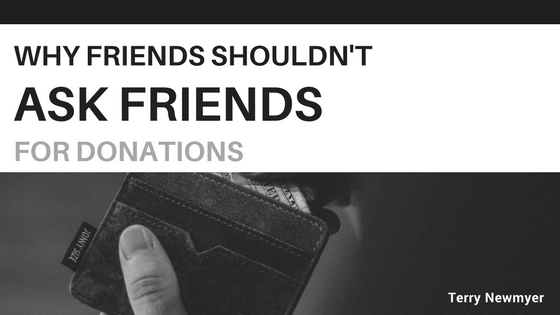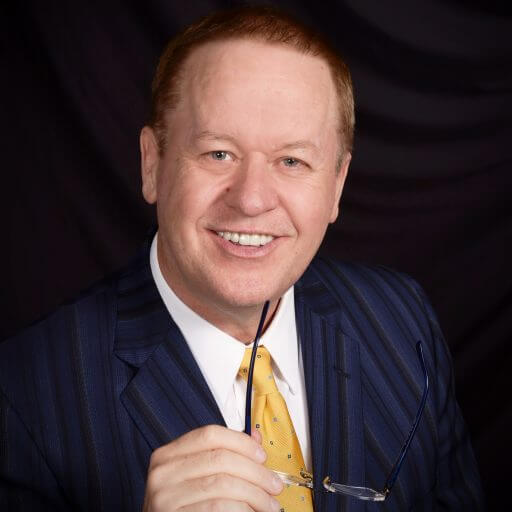
Why Friends Should Never Ask Friends for Donations
Back when I was a CDO I invited a generous community member to make a $100,000 gift for his local hospital. When he pushed back from his ravioli entrée and said “yes,” I expected a moment of cheerful celebration.
Instead, the donor immediately added these words: “But do not ever ask me to ask anyone else for a gift.”
His message made the moment awkward. I responded by saying that there must be a story behind his conviction about not asking friends.
He went on to tell me that a few years earlier a local organization he supported enlisted him as a campaign chairman to raise $100,000 for club improvements. They told him it would be an easy assignment: All he needed to do was pledge $10,000 himself and then invite nine of his friends to do the same.
He lost friends through the process. He described it as just awful to go to friends and have them turn their backs on him and later not want to speak to him.
I empathized, saying, “While we will never request that you ask for a gift, are you willing to suggest folks that we should be asking?” I added: “If so, would it be OK to have them know that you have given?”
The donor quickly said this approach would be no problem. “I am comfortable being on the team,” he said. “I just do not want to ever again ask my friends to make gifts.”
His unfortunate experience in the friends-asking-friends-for-money department isn’t necessarily the norm. Indeed, development professionals who have been in the business for a while know that such asks, when handled right, can be powerfully effective. Something was clearly amiss in the donor’s approach with his friends. Perhaps that particular campaign didn’t provide solid training and processes. We can only guess at what went wrong.
But we don’t have to guess about the broader truth of this donor’s experience. The truth is: Many people do not feel comfortable asking their friends for money.
And yet it is those very people – friends of your board members, campaign volunteers and engaged donors – who are some of your best potential prospects.
This can be a real dilemma.
Fortunately, the team approach based on Malcolm Gladwell’s best-selling book, The Tipping Point, is a good solution. It allows a more effective process in which friends simply introduce the opportunity for giving to their friends but are not be expected to close the gift by making the formal solicitation.
In this scenario, a board member, campaign volunteer, physician, executive – or simply an engaged donor – plays the role of Connector. This Connector introduces his or her friend to the staff development professional with whom the Connector is working. From this point forward, the Connector can be as much or as little engaged in the process and with the development team as is comfortable for him or her.

Healthcare, Meet Philanthropy
The rising tide of healthcare costs will soon reach a head. National healthcare expenditures (NHE) totaled around $3 trillion in 2013, and there seems to be no sign of it slowing down. In fact, the Center for Medicare and Medicaid Services (CMS) projects health care costs to rise at a rate of about 5.8 percent each year during the 10 year period from 2014-2024. On top of that, the growth rate of those rising health care costs during that time is expected to be about 1.1 percent greater than GDP. Eventually, health care costs will compose almost a fifth of total GDP.
That’s a lot to digest. The long and short of it is that health care is costing us. A lot.
Now, before we get any deeper, we’re going to have to address the elephant in the room: politics. Healthcare is a deeply politicized issue. After all, it has been a major target of reform during the Obama administration. Today, it is debated on the national stage by those on the left and the right who hope to be his successor. Civil debate and argument is a defining feature of American politics, and we should encourage an open and honest dialogue with those who agree with and oppose our views. But here’s the thing— healthcare costs don’t tow a party line. Even if, suddenly, taxpaying citizens were no longer expected to pay a single dime for healthcare, the price remains the same. Costs don’t disappear like magic by the thud of Congress’s gavel or the stroke of the executive’s pen; it does, however, become a matter of who’s paying for it. That, friends, is a decidedly political question for another post for another time.
But why is such a cost surge on the horizon? In the opinion piece “The coming tsunami will radically change healthcare philanthropy— will you be ready?”, Steven A. Reed explains that it has to do with rapidly changing demographics. In short, the Baby Boomers who made up a large part of the workforce are approaching an age at which health care costs shoot up, and Gen X-ers (millennials) are going to have to foot the bill. However, today’s generation is experiencing a lower birth rate that has resulted in about nine million fewer people than their parents’ generation. Fewer working people means less tax revenue, so when the bill arrives, the entire generation will come up short. This is an impossible task of Penrose proportions not because the millennial generation is lazy, but “because it doesn’t have the critical mass.”
So what are we to do? This is the moment, Reed argues, that philanthropy comes in. We need to embrace the American spirit of giving, and take joy in reaching out and giving back. We have a collective desire to see everyone happy and healthy, and we should do our best to make that happen. We need to fundraise, and quite a bit— more than twice as much, in fact.
For those of us who may be concerned about our organization’s ability to raise that many funds, Reed directs us to the Association for Healthcare Philanthropy’s Healthcare Philanthropy Journal. The Spring 2014 issue presented data proving that an organization’s fundraising expenditure budget was the greatest predictor of fundraising success. Or more simply, “the more you spend, the more you make.”
Now’s the time for us to reassess our organizations’ giving habits. Are we giving because we’re expected to? Because it makes us feel good? Those are two popular reasons, yes. But maybe we should think about giving as a duty. Charged with the task of assisting our countrymen, we can take on any economic threat.

An Awesome “No”
When I first entered the assignment of Chief Development Officer, my philanthropy coach taught me the best methods to ask for a major gift. She had great life experiences, raising millions from donors, and she walked on water when it came to teaching and exercising wholesome influence.
Early in my training the day came when we were scheduled to meet with a community philanthropist at his office. It was our strategy to ask for a six figure gift. My coach offered to present the close and suggested that I express some words to warm the discussion.
As we arrived for the meeting the tone was cordial and upbeat. My coach and I were well acquainted with our donor and he showed positive engagement. After a twenty minute discussion of pleasant exchanges my coach laid out our appreciation for his friendship, the case for a major gift, and asked for a pledge.
I was prepared for a favorable result, given all the positive signals. But, instead the philanthropist responded with “an awesome no” … Not a maybe, just a definitive no.
I thought I was about to fall out of my chair. I wanted to shrink and become invisible. It was a moment I did not expect. I felt really awkward.
However, my coach was so gracious. She showed empathy for his philanthropy priorities. She agreed that he could not make large gifts to every worthy cause. She kindly let him know that she understood his conclusion and how we still valued his friendship.
Before leaving the office we returned to some fun banter and then a few minutes later we adjourned. As we walked into the parking lot I looked at my coach in amazement and asked how she felt about what happened?
She replied with ease, saying that we did good work. She explained that we gave him an opportunity that he was not ready to accept. She pointed out how much time we had talked about his potential gift as we had prepared for the meeting and getting to a clear result was important to our process. She treated the outcome as useful research. It was not distressing to her. Her point was simply that we could now shift the time we we were dedicating to cultivate him to another worthy donor.
How often in life are there circumstances when we need to hear an “awesome no,” so we can move on with our purpose? How often do we resist calling for the decision because we fear the “awesome no?”
I learned a lesson from my coach that day about the value to hear the word “no.” If an “awesome no” is coming, it seems useful to get that understood. The word “no” can open new paths for making healthy adjustments as we navigate our responsibilities in work and life.
About Terry Newmyer
In 2013, Terry Newmyer came to Florida and opened the Strategies Now office, where he delivers marketing strategies to clients and works across multiple industries to support growth and development to achieve the projected results of their vision.
Early Career and Healthcare
Soon after receiving his Master’s degree at Andrews University, Terry became the Senior Vice President of the Lakeland Regional Health System in St. Joseph, Michigan, where he was responsible for marketing, planning, communications, managed care, education, physician services, and foundation management. Between 1988 and 1994, Terry helped increase the system-wide revenue from $65 million annually to $250 million. Terry later moved to Dallas and worked as a consultant for KPMG LLP, National Strategy Practice, where he started as a Manager and became a partner. There, Terry was responsible for launching a new consulting office that within two years of opening included twenty consultants and was achieving $10 million of annual revenue.
Terry Newmyer went on to found Strategies Now Inc., where he now serves as Managing Director. Terry then moved to Florida, where he resides today, to continue his work at Florida Hospital as the Senior Vice President of Business Development and Chief Development Officer. One achievement at Florida Hospital included securing sixteen new alliance contracts worth over $90 million of net value to the Hospital with various Fortune 500 companies such as GE, Walt Disney World, Olympus, and Nike. In 2007, the company completed a $100 million fundraising campaign over a year ahead of schedule and the following year exceeded the goal by $30 million.
Terry Newmyer was eventually offered a position as the President and CEO of Northern California Network Adventist Health in California and was responsible for the management of five different hospitals. During his tenure, the flagship hospital, St. Helena Napa Valley, earned the designation from NRC Picker for being the hospital in the Western USA with the highest overall patient satisfaction and received five-star recognition from Health Grades in twelve different service lines.
Education
Terry attended Atlantic Union College in Massachusetts for his undergraduate studies, where he received of Bachelor of Science in Business Administration and was awarded distinguished honors as a cross scholar. Upon graduation, he attended Andrews University in Michigan for his Master of Business Administration with an emphasis in marketing.
At Andrews University, Terry Newmyer was the Coordinator of Student Labor and housing, the Director of Marketing and Student Financial Services. He was also the President of Andrews Industries. Terry was responsible for various ranges of tasks, including managing a student apartment complex, networking both in and outside of the college community, keeping records of student finances, and managing diversified enterprises at Andrews University. As the President of Andrews Industries, Terry Newmyer was responsible for six businesses that that included a furniture factory, printer, bindery, retail plaza, motel, and an electronics company.
Strategies Now, Inc.
Case Studies of Strategies Now, Inc.
Strategic Positioning: Coordinating Your Relationships and Assets to Improve Your Key Metrics and Yield
Case Studies:
Revenue Growth: Drive Growth through Your Product Portfolio Decisions, Communications, and Intended Market Reach
Case Studies:

Philanthropy: Significant Wealth is Achievable from Fundraising Initiative through High-Synergy Teamwork
Case Studies:

Management Outsourcing: Secure Management for New Ventures or Small Business without Compromising Excellence
Case Studies:


